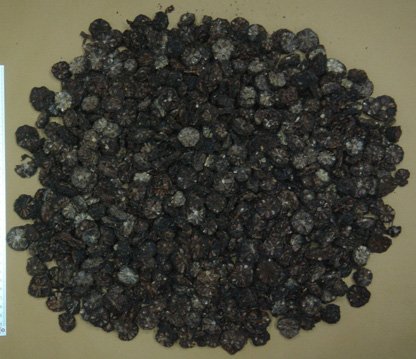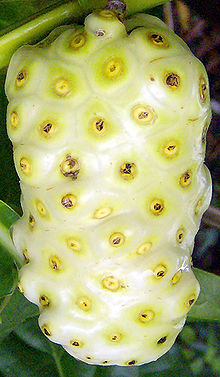NONI
Scientific Name: Morinda citrifolia Linn.
Family: Rubiaceae
Common Names: Indian Mulberry (Engl.), Wild pine (Engl.), Tahitian noni (Engl.), Pain-killer tree (Engl.), Great morinda (Engl.), Rukurok (Kuy.), Bankuru (Tag.) Apatot (Ilk.), Bangkoro (Tag.), Hai ba ji (Chin.)
Morinda citrifolia is a tree in the coffee family, Rubiaceae. Its native range extends through Southeast Asia and Australasia, and the species is now cultivated throughout the tropics and widely naturalized. The tree can grow to as tall as 10 feet and bears a fruit about the size of a potato which starts out green and ripens into yellow or white. The juice, fruit, bark, and leaves are used in herbal remedies and Polynesian folk medicine. Leaves are broadly elliptic to oblong, 12 to 25 centimeters long, with pointed or blunted tips. Peduncles are leaf-opposed, solitary, 1 to 3 centimeters long. Flowers are not bracteolate, and form dense, ovoid or rounded heads, and are 1 to 1.5 centimeters. Calyx is truncate. Corolla is white, 1 centimeter long; limb is 5-lobed, 1 centimeter in diameter. Fruit is fleshy, white or greenish white, ovoid, 3 to 10 centimeters long, with the odor of decaying cheese.
PARTS USED:
 |
| Flower |
 |
| Seeds with pulp |
 |
| Leaves |
 |
| Dried seeds |
 |
| Bark |
 |
| Fruit |
-Fruit and fruit juice contains phytochemicals: lignans, polysaccharides, flavonoids, iridoids, nonisides, scopoletin, alkaloids (xeronine), Vitamins and Minerals: magnesium; iron; potassium; selenium; zinc; copper; sulfur; ascorbic acid (vitamin C).
-Root bark contains a crystal glucoside, morindine (C27H10O15), Morindone, Anthraquinones (damnacanthal)
- Leaves yield flavanol glycosides, beta-carotene and iridoid glycosides.
-Foliage and Cell suspensions: Anthraquinones (damnacanthal), Glycosides (flavonol glycoside; iridoid glycoside, “citrifolinoside”).
-Methanol extract of Morinda citrifolia fruits contains 6alpha-hydroxyadoxoside, 6beta,7beta-epoxy-8-epi-splendoside, americanin A, narcissoside, asperuloside, asperulosidic acid, borreriagenin, citrifolinin B epimers a and b, cytidine, deacetylasperuloside, dehydromethoxygaertneroside, epi-dihydrocornin, d-glucose, d-mannitol, methyl alpha-d-fructofuranoside, methyl beta-d-fructofuranoside, nicotifloroside, 2-methoxy-1,3,6-trihydroxyanthraquinone, and beta-sitosterol 3-O-beta-d-glucopyranoside.
TRADITIONAL USES:
-In the Philippines, fruit is used as emmenagogue.
- In Malaysia, heated leave applied to the chest and abdomen for coughs, nausea, colic, enlarged spleen, and fever.
- In Indo-China, leaves used as deobstruent and emmenagogue.
- In Bombay leaves applied externally for wound healing, and internally, as tonic and febrifuge.
- In Java, juice of fruit pulp, mashed with sugar, is slightly laxative.
- Syrup of fruit juice used as a gargle for sore throats.
- Fruit used internally in various preparations for swollen spleen, liver diseases, beriberi, hemorrhage, and coughs.
- Leaves, fruit, flowers or bark used for eye problems, wounds, abscesses, fever, constipation.
- Leaf juice used for arthritis.
- Used for bone and wound healing.
- In India roots used as cathartic.
-The green fruit, leaves, and root/rhizomes were traditionally used in Polynesian cultures to treat menstrual cramps, bowel irregularities, diabetes, liver diseases, and urinary tract infections.
PHARMACOLOGICAL ACTIVITY:
- Antimicrobial / insecticidal properties
Specific compounds from various parts of the noni plant have been effective in laboratory studies as antibacterial agents, supporting the Polynesian traditional medicinal use for infectious diseases. [28][29] In an in vitro study, extracts from the ripe noni fruit, including L-asperuloside and alizarin, exhibited moderate antibacterial properties against Pseudomonas aeruginosa, Micrococcus pyrogenes, Escherichia coli, Pseudomonas aeruginosa, Proteus morgaii, Staphylococcus aureus, Bacillis subtilis, Salmonella, and Shigela. [20] Some anthraquinone compounds from noni roots were also effective against strains of Pseudomonas aeruginosa, Proteus morgaii, Staphylococcus aureus, Bacillis subtilis, Escherichia coli, Salmonella, and Shigela. [19] Specifically, the compound scopoletin from noni inhibits the activity of Escherichia coli and H. pylori. [21] Also, a concentrated noni leaf extract killed 89% of Mycobacterium tuberculosis in a test tube, compared to rifampin, a leading anti-tuberculosis drug, which has an inhibition rate of 97% at the same concentration. [22]
- Analgesic
Study suggests the alcoholic extract of fruits of Moringa citrifolia appears to have an analgesic effect. Morphine sulfate was the reference drug. [15] A Morinda citrifolia extract showed a significant, dose-related, central analgesic effect in mice, which was 75% as strong as morphine, yet non-addictive and side effect-free. [17] In a similar study, Tahitian Noni® juice (TNJ) had a dose-dependent analgesic effect on antimony potassium tartrate-induced pain in mice and rats. [10] In an acetic acid-induced writhing test in mice, the alcoholic extract of Morinda citrifolia fruits had a dose-dependent inhibitory effect, starting at 4g/kg, which was similar to that produced by morphine in a dose of 1.5mg/kg. [15] The antinociceptive effect in the writhing test was statistically significant (p<0.001) for 15 minutes until five hours after administration. In a Phase I trial in cancer patients, there was a statistically significant (t(35)=-2.84, p=0.006) decrease in pain interference after a week of noni in doses of 2, 4, 6, 8, or 10g. [18]
- Herbal Hepatotoxicity
Report of a case of hepatotoxicity from a three-week history of drinking Noni juice. Pathology was confirmed by liver biopsy. Transaminase levels normalized within a month. [13]
- Antiviral / Cytotoxicity
Study of fruit juice of M. citrifolia displayed marked cytotoxicity in lymphocyte (MT-4) cells and inhibition of HCV subgenomic replicon replication in Huh 5-2 cells. [16]
- Antipsychotic-like Activity
Study evaluated the antipsychotic effects of noni fruits using mouse models of apomorphine-induced climbing behavior and methamphetamine-induced stereotype (licking, biting, gnawing, sniffing). Results showed an antidopaminergic effect of Morinda citrifolia in mice, suggesting an antipsyhcotic effect that may be utilized in the treatment of psychiatric disorders. [23]
TOXICITY:
The usual recommended dose of noni juice is 30 mL/day, which would result in the intake of 1.66 mEq/d of potassium. Given that the potassium content of noni juice is 56.3 mEq/L, patients with renal dysfunction who drink large volumes of noni juice may be at risk for hyperkalemia. Patients with kidney disease and unexplained hyperkalemia should be queried about their ingestion of herbal remedies and alternative medicine products because noni may increase potassium levels. [25]
A few cases of hepatitis in people who had been drinking noni juice have been reported, even though no causal link could be established between the liver injury and ingestion of the juice. To more fully evaluate the hepatotoxic potential of noni fruit juice, in vitro hepatotoxicity tests were conducted in human liver cells, HepG2 cell line. [26]
REFERENCES:
- List of Philippine Herbal Medicinal Plants. May 2014. Apatot. http://stuartxchange.com/Apatot.html
- The American Cancer Society. November 1, 2008. Noni Plant. http://www.cancer.org/treatment/treatmentsandsideeffects/complementaryandalternativemedicine/dietandnutrition/noni-plant
- Nelson, SC. April 2006. Morinda citrifolia (noni). http://www.agroforestry.org/images/pdfs/Morinda-noni.pdf
- College of Tropical Agriculture and Human Resources. December 7, 2006. The Noni Website.http://www.ctahr.hawaii.edu/noni/botany.asp
- Virgin Noni Juice. 2010. Components of Noni fruit. http://www.virginnonijuice.com/components-of-noni-fruit.htm
- Samoylenko, V., Zhao, J., Dunbar, DC., Khan, IA., Rushing, JW., Muhammad, I. July 21, 2006. New Constituents from Noni (Morinda citrifolia) Fruit Juice. http://pubs.acs.org/doi/abs/10.1021/jf060672u
- Sigma-Aldrich. 2010. Noni (Morinda citrifolia). http://www.sigmaaldrich.com/life-science/nutrition-research/learning-center/plant-profiler/morinda-citrifolia.html
- Su, BN., Pawlus, AD., Jung, HA., Keller, WJ., Mclaughlin, JL., Kinghorn, AD. 2005. Chemical Constituents of the Fruits of Morinda citrifolia (Noni) and Their Antioxidant Activity. http://herbs.ph/attachments/article/1984/Chemical%20Constituents%20of%20the%20Fruits%20of%20Morinda%20citrifolia%20(Noni)%20and%20Their%20~.pdf
- Wang, MY et al. December 23, 2002. Morinda citrifolia (Noni): A literature review and recent advances in Noni research1.http://www.sld.cu/galerias/pdf/sitios/mednat/morinda_citrifolia_(noni)_a_literature_review_and_recent_advances_in_noni_research.pdf
- Wang, MY., West, BJ., Jensen, CJ., Nowicki, D., Su, C., Palu, AK., Anderson, G. December 23, 2002. Morinda citrifolia (noni): a literature review and recent advances in Noni research. http://www.ncbi.nlm.nih.gov/pubmed/12466051.
- Bruno, G. 2014. Goji & Noni: A Review of Two Traditional Medicinal Juices-Informed Opinion.http://www.naturalhealthresearch.org/goji-noni-a-review-of-two-traditional-medicinal-juices/
- Wang, MY., Su, C. Cancer Preventive Effect of Morinda citrifolia (Noni). http://www.nonijuicecentral.com/antioxidant.pdf
- Herbal hepatotoxicity: acute hepatitis caused by a Noni preparation (Morinda citrifolia) / Millonig Gunda et al / European Journal of Gastroenterology & Hepatology: • April 2005 - Volume 17 - Issue 4 - pp 445-447
- Millonig, G., Stadlmann, S., Vogel, W. April 2005. Herbal hepatotoxicity: acute hepatitis caused by a Noni preparation (Morinda citrifolia). http://journals.lww.com/eurojgh/Abstract/2005/04000/Herbal_hepatotoxicity__acute_hepatitis_caused_by_a.9.aspx
- Punjanon, T. and Nandhasri, P. Analgesic effect of the alcoholic extract from the fruits of Morinda citrifolia 2005;4:678
- Studies of antiviral activity and cytotoxicity of Wrightia tinctoria and Morinda citrifolia / P selvam et al / Indian J Pharm Sci 2009;71:670-2 / DOI: 10.4103/0250-474X.59550
- Younos, C., Rolland, A., Fleurentin, J., Lanhers, MC., Misslin, R., Mortier, F. October 1990. Analgesic and behavioural effects of Morinda citrifolia. http://www.ncbi.nlm.nih.gov/pubmed/1981810
- Issell, B. F., Gotay, C., Pagano, I., and Franke, A. Quality of life measures in a phase I trial of noni 2005
- ATKINSON, N. Antibacterial substances from flowering plants. 3. Antibacterial activity of dried Australian plants by a rapid direct plate test. Aust J Exp Biol Med Sci 1956;34(1):17-26
- Bushnell, O. A., Fukuda, M., and Makinodian, T. The antibacterial properties of some plants found in Hawaii. Pac Sci 1950;4:167-183.
- Duncan, S. H., Flint, H. J., and Stewart, C. S. Inhibitory activity of gut bacteria against Escherichia coli 0157 mediated by dietary plant metabolites. FEMS Microbiol Lett 1998;164:283-285.
- Saludes, J. P., Garson, M. J., Franzblau, S. G., and Aguinaldo, A. M. Antitubercular constituents from the hexane fraction of Morinda citrifolia Linn. (Rubiaceae). Phytother Res 2002;16(7):683-685.
- Antipsychotic-like activity of Noni (Morinda citrifolia Linn.) in mice / Vijayapandi Pandy*, Megala Narasingam and Zahurin Mohamed / BMC Complementary and Alternative Medicine 2012, 12:186 doi:10.1186/1472-6882-12-186
- Wolters Kluwer Health. 2009. Noni. http://www.drugs.com/npp/noni.html
- Mueller B, Scott MK, Sowinski KM, Prag KA. Noni juice ( Morinda citrifolia ): hidden potential for hyperkalemia? Am J Kidney Dis .2000;35(2):310-312.
- West, BJ., Su, CX., Jensen, CJ. October 2009. Hepatotoxicity and subchronic toxicity tests of Morinda citrifolia (noni) fruit.http://www.ncbi.nlm.nih.gov/pubmed/19797868
- Stadlbauer, V et al. 2005. Hepatotoxicity of NONI juice: Report of two cases.http://herbs.ph/attachments/article/1994/Hepatotoxicity%20of%20NONI%20juice%20Report%20of%20two%20cases.pdf.
- Locher, CP., Burch, MT., Mower, HF., Berestecky, J., Davis, H., Van Poel, B., Lasurre, A., Vanderberghe, DA., Vlietinck, AS. Anti-microbial activity and anti-complement activity of extracts obtained from selected hawaiian medicinal plants. J Ethnopharmacol 11-17-1995; 49(1): 23-22.
- Leach, AJ., Leach, DN., Leach, GJ. Antibacterial activity of some medicinal plants of Papua New Guinea. Sci New Guinea 1988; 14: 1-7.
compiled by: HOT

No comments:
Post a Comment